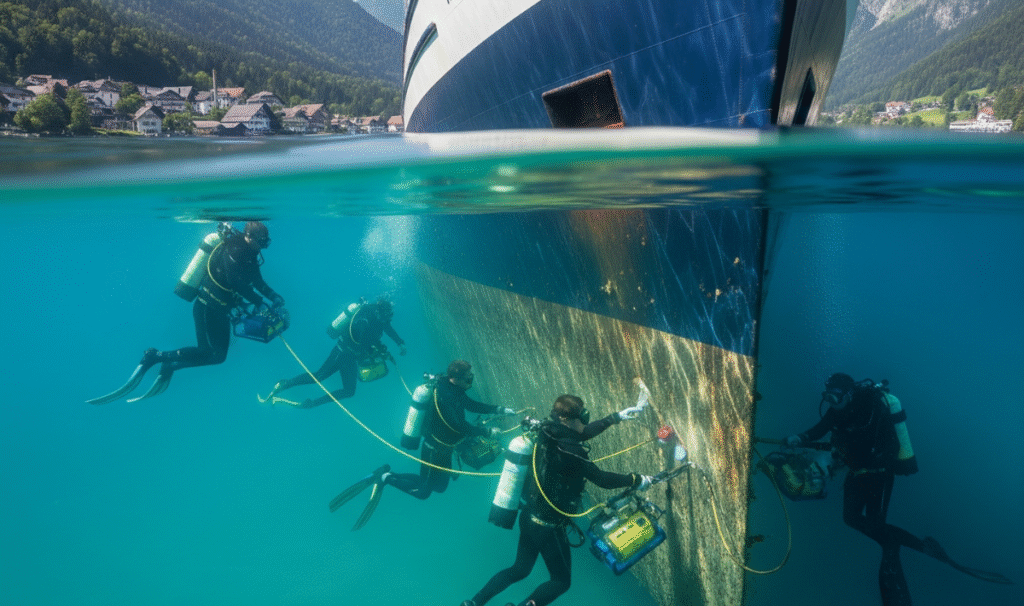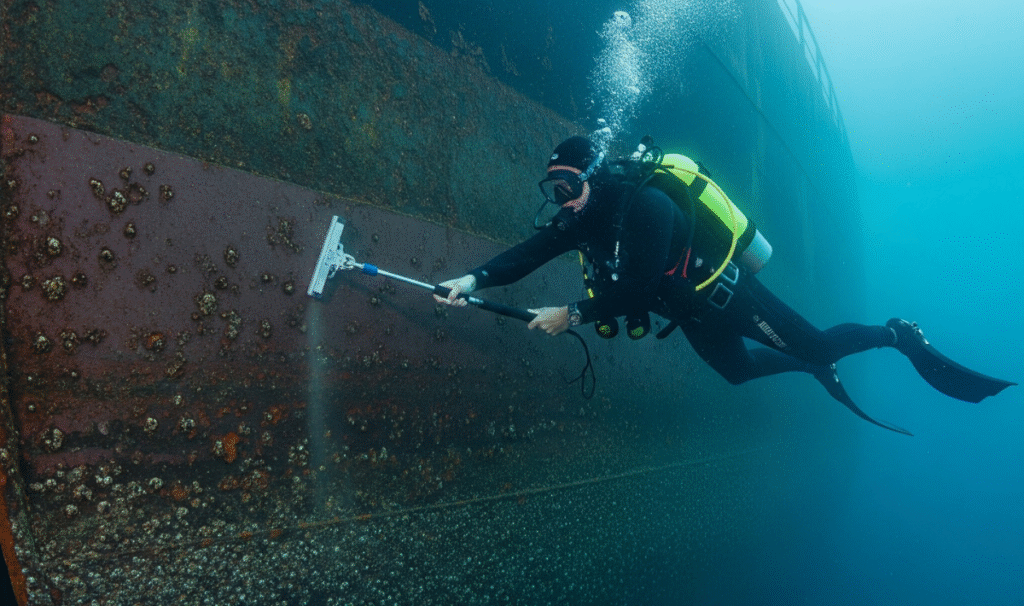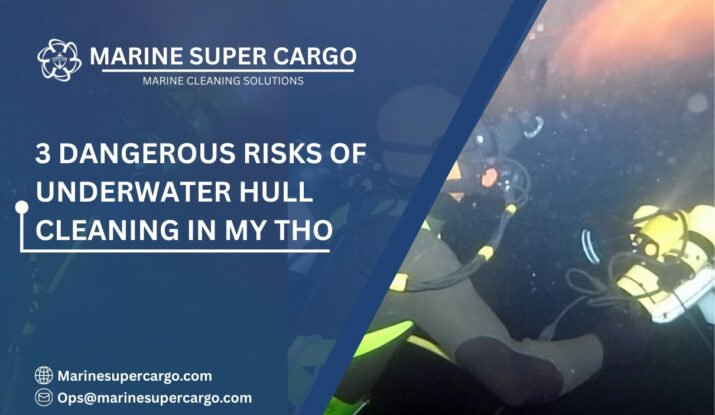You captain a vessel on the famed Mekong River, you know that underwater hull cleaning in My Tho isn’t just a tick on your maintenance checklist—it’s the engine of smooth, efficient, and economical operations. Picture your hull as a swimmer’s foot: sleek and powerful when clean, but bogged down and clumsy when caked in mud and weeds. My Tho’s nutrient-rich rivers, buzzing with life and trade, invite quick fouling, and a dirty hull means sluggish progress, steeper fuel bills, and avoidable headaches. Dive into everything you need to know to keep your hull—and your business—running at peak performance.
Why Underwater Hull Cleaning in My Tho is Essential
Vessel hulls in My Tho’s waters act like magnets for barnacles, algae, mussels, and silt. This biofouling may seem harmless at first, but it adds drag, increases fuel consumption, and stresses engines. Ignored, it amplifies the risks of corrosion, blocks vital systems, and attracts the attention of port regulators. Hull cleaning is the foundation of efficiency and reliability for any boat plying the Mekong’s busy shipping lanes.
Understanding My Tho’s Riverine Environment and Fouling Challenges
Situated at the mouth of the Mekong Delta, My Tho experiences a dynamic blend of tidal saltwater and inland freshwater flows. This warm, nutrient-rich mix creates ideal conditions for rapid biofouling. Frequent rains, seasonal floods, and continuous marine traffic further intensify the issue. Vessels left idle can accumulate significant fouling within weeks, especially during the rainy season.
To ensure responsible hull maintenance, vessel owners must comply with local laws and international marine pollution standards outlined in the MARPOL Convention.
Risks of Neglecting Underwater Hull Cleaning in My Tho’s Waterways
Skipping underwater hull cleaning in My Tho means facing:
- Higher fuel consumption by up to 15–20% due to extra drag.
- Sluggish acceleration, slower river journeys, and decreased maneuverability.
- Accelerated corrosion or coating breakdown, leading to expensive repairs.
- Blocked intakes and propellers, risking engine failure or overheating.
- Fines, operational delays, or denied port entry from authorities monitoring environmental compliance.

The Process of Underwater Hull Cleaning in My Tho
Initial Inspection and Planning
Pro cleaning teams always begin with a full underwater hull inspection using divers and underwater cameras. They assess fouling, check for hidden damage, and plan the cleaning method—critical in My Tho’s murky waters.
Essential Tools, Techniques, and Professional Practices
- Rotary brushes and gentle scrapers lift barnacles and slime without harming protective coatings.
- High-pressure jets and specialized vacuums rid hulls of soft and hard growth while containing debris.
- Propeller polishing and anode inspection are usually included for peak efficiency.
- Underwater video documentation provides before-and-after proof and reassurance for clients.
- All debris is collected for proper disposal, safeguarding the delta’s ecology.
How to Choose the Right Hull Cleaning Service in My Tho
Certifications, Experience, and Local Expertise
Always insist on commercial diver certification and up-to-date insurance. My Tho’s complex riverine system demands experience—ask for references from local boaters familiar with regional fouling patterns.
Choose providers who offer detailed inspection reports, compliance documentation, and follow strict safety and environmental standards. Crews should also understand international maritime obligations like those set by the International Maritime Organization (IMO), ensuring operations meet both Vietnamese and global expectations for safe and sustainable underwater hull cleaning in My Tho.
Cleaning Frequency Suited to My Tho’s Vessels
Given My Tho’s fast-fouling waters, hulls need cleaning every 1–3 months. Idle ships and barges demand more frequent service, while active riverboats and ferries still benefit from regular marine grooming.
Environmental Regulations and Responsible Practices
Vietnam’s environmental standards require:
- Debris control: No waste or fouling material can be released into the Mekong Delta’s sensitive waterways.
- Eco-friendly techniques: Cleaning must avoid toxic chemicals or abrasive methods that harm aquatic habitats.
- Documentation: If invasive species are found, authorities must be notified immediately, and all cleaning activities must be fully documented for inspection.
These practices align with international efforts promoted by the International Association of Ports and Harbors (IAPH), supporting global marine sustainability and port compliance.
Cost Expectations for Underwater Hull Cleaning in My Tho
Pricing for underwater hull cleaning in My Tho typically ranges from USD 6–13 per foot, varying by vessel size, fouling severity, and any added inspections or services. While the cost is routine, the savings in fuel and repairs multiply over time.
DIY vs. Professional Hull Cleaning: Pros and Cons
DIY cleaning may seem thrifty, but it comes with major risks—safety hazards, incomplete cleaning, environmental violations, and lack of acceptable documentation. Professionals guarantee thorough cleaning, record-keeping, and debris containment that meet legal and class society standards.

Key Benefits: Efficiency, Longevity, and Compliance
- Up to 20% fuel savings with a streamlined hull
- Better speed and maneuverability, especially on tight, busy river runs
- Reduced haul-out and dry-dock time for repairs
- Smoother port clearances and audit compliance
- Early warning for mechanical issues before they become emergencies
Real Experiences from My Tho Mariners
Commercial captains and tour operators in My Tho often report that their boats “run quieter, faster, and need fewer emergency stops” after regular hull cleaning. A cargo barge owner noted that routine cleaning saved nearly 15% on diesel over a season, while ferry operators praised the improved docking agility and quicker turnaround for passengers.
Conclusion:
Underwater Hull Cleaning in My Tho is your vessel’s first defense against drag, damage, and financial drain. Team up with expert local professionals, follow a regular cleaning schedule, and commit to sustainable, eco-safe practices. Your reward: faster trips, longer hull life, fewer surprises—and more time enjoying the Mekong.
FAQ:
Q1. How often should I schedule hull cleaning in My Tho?
Every 1–3 months fits most commercial and recreational boats, with monthly service best for idle or frequently fouled vessels.
Q2. Are cleaning methods in My Tho environmentally sound?
Yes, when performed by certified providers using debris containment and non-toxic techniques as standard.
Q3. What are the typical costs in My Tho?
Expect USD 6–13 per foot, plus extra for optional inspections, propeller polishing, or urgent call-outs.
Q4. Is DIY hull cleaning recommended?
Not in My Tho. Strong currents, safety risks, and compliance documentation requirements favor certified professionals.
Q5. What’s the biggest benefit of regular hull cleaning?
Lower fuel costs, better reliability, longer hull and engine life, and stress-free navigation up and down the Mekong’s legendary riverways.


